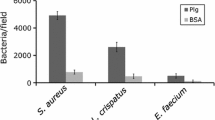Abstract
Staphylococcus aureus has been shown to bind to human platelets through a variety of surface molecules, including serine-rich adhesin for platelets (SraP). The SraP mutant strain of S. aureus is significantly impaired in its ability to initiate infection compared with the wild strain. SraP is a cell wall-anchored, glycosylated protein. A previous study revealed that SecY2, Asp1, Asp2, Asp3, and SecA2 in the SraP operon were required for the efficient transport of glycosylated SraP from the cytoplasm to the bacterial cell surface. However, no glycosyltransferase (Gtf) was found to be involved in the glycosylation of SraP. In this study, SraP was found in all of the 55 clinical isolates of S. aureus using a real-time polymerase chain reaction assay. Sequence and phylogenetic analysis showed that GtfA and GtfB in the SraP operon were highly conserved in most of these clinical isolates. Conserved domains analysis revealed that both GtfA and GtfB contained a GT1_GtfA-like domain. Structural homology analysis inferred that they are both Gtfs. We then constructed an in vivo glycosylation system in Escherichia coli using SraP1–743 as the substrate and GtfA and GtfB as the Gtfs. Using this system, we found that GtfA and GtfB were the Gtfs that transferred the N-acetylglucosamine-containing oligosaccharides to the recombinant SraP1–743. Deletion of either one or both of the Gtfs abolished the glycosylation of SraP. In summary, GtfA and GtfB in the SraP operon are highly conserved in most clinical isolates of S. aureus, and both GtfA and GtfB are required for SraP glycosylation.


Similar content being viewed by others
References
Bennett-Lovsey RM, Herbert AD, Sternberg MJ et al (2008) Exploring the extremes of sequence/structure space with ensemble fold recognition in the program Phyre. Proteins 70:611–625
Bensing BA, Siboo IR, Sullam PM (2007) Glycine residues in the hydrophobic core of the GspB signal sequence route export toward the accessory Sec pathway. J Bacteriol 189:3846–3854
Bu S, Li Y, Zhou M et al (2008) Interaction between two putative glycosyltransferases is required for glycosylation of a serine-rich streptococcal adhesin. J Bacteriol 190:1256–1266
Fitzgerald JR, Foster TJ, Cox D (2006) The interaction of bacterial pathogens with platelets. Nat Rev Microbil 4:445–457
Guerin ME, Kordulakova J, Schaeffer F et al (2007) Molecular recognition and interfacial catalysis by the essential phosphatidylinositol mannosyltransferase PimA from mycobacteria. J Biol Chem 282:20705–20714
Li Y, Chen Y, Huang X et al (2008) A conserved domain of previously unknown function in Gap1 mediates protein–protein interaction and is required for biogenesis of a serine-rich streptococcal adhesin. Mol Microbiol 70:1094–1104
Naffa RG, Bdour SM, Migdadi HM et al (2006) Enterotoxicity and genetic variation among clinical Staphylococcus aureus isolates in Jordan. J Med Microbiol 55:183–187
Rigel NW, Braunstein MA (2008) New twist on an old pathway—accessory Sec [corrected] systems. Mol Microbiol 69:291–302
Seepersaud R, Bensing BA, Yen YT et al (2012) The accessory Sec protein Asp2 modulates GlcNAc deposition onto the serine-rich repeat glycoprotein GspB. J Bacteriol 194:5564–5575
Siboo IR, Chambers HF, Sullam PM (2005) Role of SraP a serine-rich surface protein of Staphylococcus aureus in binding to human platelets. Infect Immun 73:2273–2280
Siboo IR, Chaffin DO, Rubens CE et al (2008) Characterization of the accessory Sec system of Staphylococcus aureus. J Bacteriol 190:6188–6196
Stephenson AE, Wu H, Novak J et al (2002) The Fap1 fimbrial adhesin is a glycoprotein: antibodies specific for the glycan moiety block the adhesion of Streptococcus parasanguis in an in vitro tooth model. Mol Microbiol 43:147–157
Takamatsu D, Bensing BA, Sullam PM (2004) Genes in the accessory sec locus of S, gordonii have three functionally distinct effects on the expression of the platelet-binding protein GspB. Mol Microbiol 52:189–203
Van Belkum A, Kluytmans J, van Leeuwen W et al (1995) Multicenter evaluation of arbitrarily primed PCR for typing of Staphylococcus aureus strains. J Clin Microbiol 33:1537–1547
Vetting MW, Frantom PA, Blanchard JS (2008) Structural and enzymatic analysis of MshA from Corynebacterium glutamicum: substrate-assisted catalysis. J Biol Chem 283:15834–15844
Wu R, Wu H (2011) A molecular chaperone mediates a two-protein enzyme complex and glycosylation of serine-rich streptococcal adhesins. J Biol Chem 286:34923–34931
Zhou M, Wu H (2009) Glycosylation and biogenesis of a family of serine-rich bacterial adhesins. Microbiology 155:317–327
Acknowledgments
This study was supported by Grants 30970060 and 81371779 from the National Natural Science Foundation of China.
Author information
Authors and Affiliations
Corresponding authors
Electronic supplementary material
Below is the link to the electronic supplementary material.
Rights and permissions
About this article
Cite this article
Li, Y., Huang, X., Li, J. et al. Both GtfA and GtfB are Required for SraP Glycosylation in Staphylococcus aureus . Curr Microbiol 69, 121–126 (2014). https://doi.org/10.1007/s00284-014-0563-2
Received:
Accepted:
Published:
Issue Date:
DOI: https://doi.org/10.1007/s00284-014-0563-2




